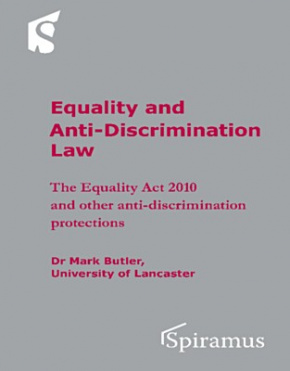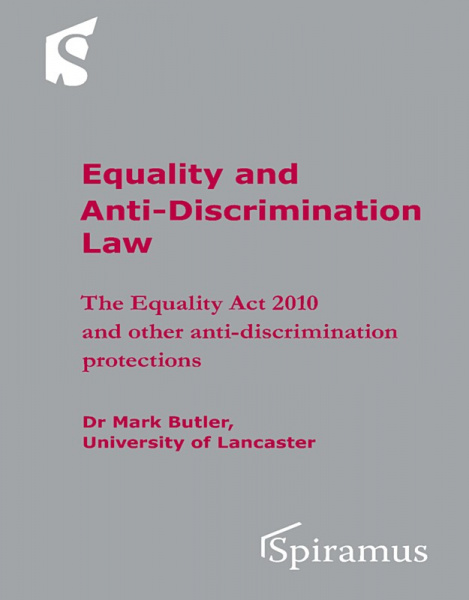Equality and Anti-Discrimination Law
The Equality Act 2010 and other anti-discrimination protections
Equality and Anti-Discrimination Law covers The Equality Act 2010 and other anti-discrimination protections both within the UK legislation and in the context of EU law.
As well as the Equality Act 2010, other key areas covered include atypical worker protection and family friendly regulation: each of these are discussed to sufficient detail to enable the reader to gain a working understanding of how each operates.The text takes account of case law from both UK courts, and European Courts where this is needed. This helps show the interaction that UK and EU law has in the area of equality law, and how the systems are interdependent.
- AvailablePaperback9781907444470230 pagesList Price: GBP 34.95 Add to basket
- AvailablePDF9781907444562230 pagesList Price: GBP 17.48 Add to basket
Equality and Anti-Discrimination Law covers The Equality Act 2010 and other anti-discrimination protections both within the UK legislation and in the context of EU law.
The UK’s approach to ensuring equality for the workforce is notoriously difficult to navigate, with various aspects of protection being contained and discussed across a range of statutory and non-statutory instruments. Although the Equality Act 2010 is often viewed as central to the equality laws of the UK, there are other key areas that must also be borne in mind, including atypical worker protection and family friendly regulation: each of these are discussed to sufficient detail to enable the reader to gain a working understanding of how each operates.
In considering each of these key areas this text attempts to decipher and navigate each of them with the end user in mind. The protections, and the thresholds that need to be satisfied to acquire the protections, are broken down into their constituent parts and analysed using key case law and relevant codes of practices with a view to ensuring that their practical use is understood by the reader. Through adopting this approach the book ensures that the reader gets to grips with key concepts that protect on an equality footing.
The text takes account of case law from both UK courts, and European Courts where this is needed. This helps show the interaction that UK and EU law has in the area of equality law, and that the systems are interdependent to some extent.
For those wishing to go beyond the simple practical application of the law the text touches upon a number of academic debates that exist in the area of equality law, to further stimulate those with an interest in the law, but further to highlight some of the perceived weaknesses that exist with the UK’s current approach to equality protection, and whets the appetite for further discussion.
Contents
List of abbreviations
Table of authorities
1. Introduction to Equality Law
1.1. The legal landscape
1.2. Purpose of this text
1.3. Structure
2. Development of Non-Discrimination/Equality Protection
2.1. European Union Level
2.2. European Convention of Human Rights
2.3. National Level
3. Defining Equality
3.1. Introduction
4. The Equality Act 2010
4.1. Public Sector Equality Duty
4.2. Combined Discrimination
4.3. Direct Discrimination
4.4. Indirect Discrimination
4.5. Harassment
4.6. Victimisation
4.7. Vicarious Liability of Employers
4.8. Instructions to Discriminate and aiding a contravention
4.9. Discriminatory Advertisements
4.10. Disability Discrimination Protections
5. Defences
5.1. Genuine Occupational Requirements
5.2. Positive Action
5.3. Statutory Defence
5.4. Illegal contracts
5.5. National Security
6. Scope of the Equality Act 2010
6.1. Working Arrangments
7. Protected Grounds
7.1. Age
7.2. Disability
7.3. Gender Reassignment
7.4. Marriage and Civil Partnership
7.5. Race
7.6. Religion or Belief
7.7. Sex
7.8. Sexual Orientation
7.9. Pregnant Workers and Maternity
8. Evidencing Unlawful Discrimination
8.1. Burden of Proof
8.2. Presentation of a Complaint
9. Remedies for Direct and Indirect Discrimination, Harassment and Victimisation Claims
9.1. Compensation for direct discrimination, harassment and victimisation claims
9.2. Recommendation
9.3. Declaration
10. Equal Pay
10.1. Introduction
10.2. The Gender Pay Gap
10.3. The Scope of the Equal Pay Protections
10.4. The Sex Equality Clause
10.5. Choosing a Suitable Comparator
10.6. The Genuine Material Factor Justification
10.7. Bringing a Claim
10.8. Remedying Equal Pay Claims
10.9. Conclusions on Equal Pay
11. Family Friendly Policy
11.1. Introduction
11.2. Right to Request Flexible Working
11.3. Maternity, Paternity and Adoption Rights
11.4. Conclusions on family friendly policies
12. Atypical Worker Protection:
12.1. Introduction
12.2. Part-Time Worker Protection
12.3. Fixed-Term Workers
12.4. Conclusions
13. Concluding Remarks
Index


